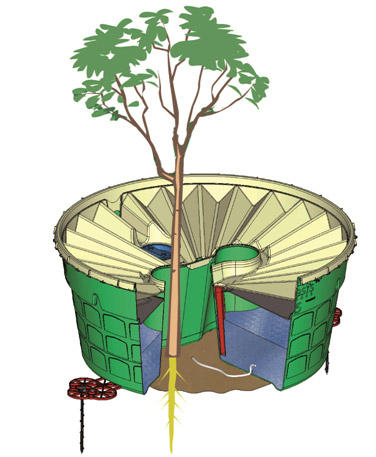The different forms of condensation
General types of condensation
When reading about condensation and the visible effects of the process, the different types of condensation are usually not well described. People often describe one of the different types of condensation – e.g. dew - as a description of the entire process and all of the different types - but this is not correct! My old grandfather used a verb for the arising of dew on plant leaves; in his dialect he called this phenomenon ‘giving out’. Ancient farmers knew well the differences between the various condensation phenomena and mechanisms that lead to the production of dew. This one phenomenon of ‘giving out’ on leaves, is the same effect as the damping process on a glass of cold wine. This is the process that the Groasis Waterboxx plantcocoon® is using.
What is condensation?
Condensation is a phenomenon that occurs when air shrinks so much that it is no longer able to capture and hold humidity. Water molecules are pressed (forced) out of the spaces between the air molecules. As a result, we see vapor (e.g. "giving out", damping, dew, mist, clouds) or water (e.g. rain, hail, snow). The moment when water molecules are pressed out of the air molecules is called the ‘dew point’.
Specific types of condensation
As temperature falls, air shrinks (becomes more dense), which ultimately produces visible water. Mostly we see the same result - water on leaves; but the cause of it is very different:
- "Giving out" > the air itself has not reached its dew-point, and no floating dew is visible. Only air that touches a cold surface, shrinks, reaches its dew point, and leaves behind water. All plants in deserts live and survive using this process; and in moderate climates, plants survive periods of drought by using the 'giving out' phenomenon. The Groasis Waterboxx plantcocoon® copies this process;
- Dew > only the lowest part of air above the soil, in the lowest point of a valley, or in a canal, reaches the dew point. In general, we see beautiful horizontal layers of dew;
- High humidity > the whole mass of air is slightly saturated, but visibility is still OK;
- Mist > the whole air is heavily saturated with water, and visibility is bad;
- Clouds around mountain tops > warm air rising against the slope gets colder, reaches its dew point, and shows itself as clouds;
- Clouds > close to Earth it's warm enough to avoid the dew point; but higher up, it's colder and clouds develop.
- 3 types of precipitation:
- Floating water molecules bind to each other (cohesion) and become too heavy to float. When they fall, we call this ‘rain’;
- Floating water molecules bind to each other, freeze into irregular lumps of ice, and become too heavy to float. When they fall, we call this ‘hail’;
- Floating water molecules bind to each other, become crystalline water (i.e. ice) too heavy to float. When they fall, we call this ‘snow’.
Waterboxx plantcocoon® design principles

The Groasis Waterboxx plantcocoon® (see the image on the right) looks simple, but the plastics and design are specifically selected and technically very important. First, the plastic used has a very high "specific heat capacity", which allows the material to absorb a lot of heat; Second, it has a low "thermal conductivity", which prevents too much movement of the heat (stays cooler, longer) already absorbed by the Waterboxx plantcocoon®.
These principles are very important to the functioning of the Waterboxx plantcocoon®. The more energy that is needed to make it warm, the longer it stays cool. When the Waterboxx plantcocoon® is cooler than the surrounding
air, the dew point is more quickly reached and condensation can occur. Every day, this subtle design feature adds to the resevoir. And so, while to humans these plastics do not appear to be important, to the plant, they can be a matter of life and death.
Additionally, the Waterboxx plantcocoon® cover has a surface like that of a lotus leaf; this was a purposeful design feature. It mimics the Lotus flower's very high water repellence (or superhydrophobicity - i.e. "difficulty to wet"). Additionally, to mimic the papillae on the epidermis of the lotus plant, the Waterboxx plantcocoon® has 1000's of tiny pyramids which reduce adhesion and encourage the ultimate condensation and capture of valuable moisture from the surrounding air.
The lid of the Waterboxx® plant cocoon ensures that the condensation which is formed in the air/on the lid of the Waterboxx®, will end up in the water tank. The advantage of this process is that when you plant trees with the Waterboxx® plant cocoon, you don’t have to refill the water tank. The box refills itself after all. More than 90% water can be saved by planting trees while you plant with the Waterboxx® plant cocoon. This makes the container particularly suitable when you have to plant in dry areas or areas where water is scarce.















